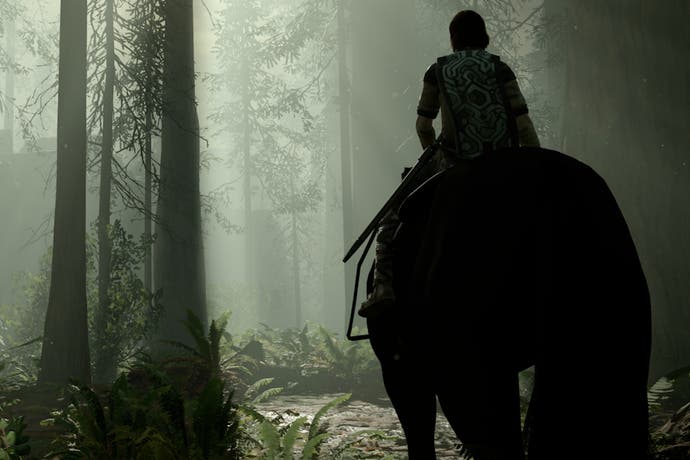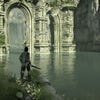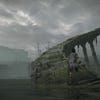Shadow of the Colossus is one of the best remakes of all time
Bluepoint's PS4 work honours the original while delivering state-of-the-art technology.
There's a reason why Team Ico's Shadow of the Colossus commands so much love and respect from the PlayStation audience. From a technical perspective, it pushed the PlayStation 2 hardware further than it had gone before, but it also delivered a special style and atmosphere that set it apart from anything else that had gone before. In essence, it was the type of game that only comes along very rarely - an experience that actually strengthens one's love for the gaming medium.
To revive such a classic in the modern age for today's console hardware is a potentially hazardous exercise, possibly even bordering on heresy - especially as the original developer was not involved in the work. What it required was a team as passionate and caring about the game as the fans that love it so much, which is precisely why Sony undertook this task by employing the masters of the remaster: Bluepoint Games.
Whether we're talking about the original Uncharted trilogy, Gravity Rush, Metal Gear Solid 2 and its sequel - or indeed the PS3 remaster of Shadow of the Colossus itself - Bluepoint has delivered tremendous remasters of beloved classics, but with the release of Shadow of the Colossus for PlayStation 4, we're looking at something new, something even more ambitious - a full on ground-up remake of the original game.
In reimagining the game for the PlayStation 4, Bluepoint had to push itself to the next level. Most of its previous projects involved translating existing games to new platforms and while some received varying degrees of reworked artwork along the way, Shadow of the Colossus marks the first time the team has recreated everything from scratch. With a new in-house art team at its disposal, Bluepoint's vision of Shadow of the Colossus combines fresh art assets with a powerful engine to create perhaps one of the most beautiful games of the generation.
Great care has been placed into rebuilding the experience: the sense of scale so critical to the original has been maintained and expanded. The world feels as vast as ever, but more powerful hardware has allowed for greatly expanded detail displayed far off into the distance. On PlayStation 2, an aggressive streaming system was used to enable seamless traversal but pulling this off required the use of flat two-dimensional imagery in the distance - it gives the impression of a large world without drawing all of the necessary geometry. It's basically an extremely aggressive LOD system and it worked but on PS4, LODs are implemented in a more modern fashion. Things like foliage can be seen drawing into view but most of the world geometry appears highly detailed even when viewed from across the map which just looks fantastic in motion.
Everything from the richly detailed valley walls to the gorgeous stone work of the central temple has been completely reworked. This is one of the riskiest parts of the project, however, as recreating the environments of such a classic experience could have impacted the atmosphere the development team worked so hard to create.
Once you sit down and begin to play, however, it feels natural - like a natural evolution of what Ueda's team envisioned in the first place. In addition, a new lighting engine further enhances this atmosphere while exhibiting its own flavour. There are tweaks and changes to the lighting throughout, but it retains the basic design language so evident in the original artwork, but other enhancements are far more pronounced: the world now features gorgeous shadow maps, which cast across the environment adding depth. In addition, a rich volumetric lighting solution is used throughout the adventure now - from the rays of light piercing the dusty temples to the sun shafts slicing across the canyon floor, the addition of volumetric lighting feels like a natural extension of what the original developers had first envisioned.


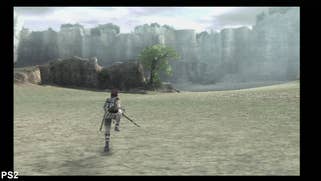
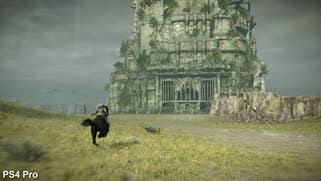
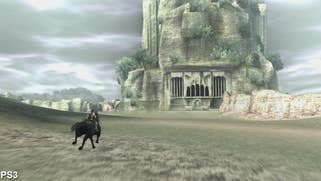
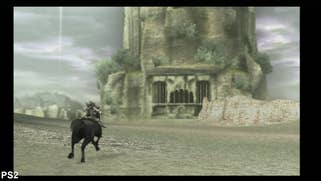
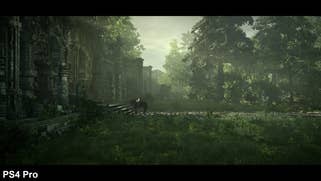
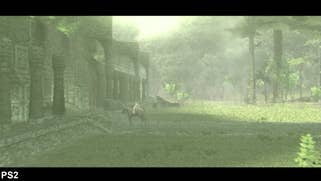

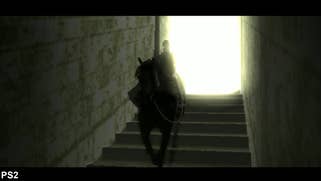
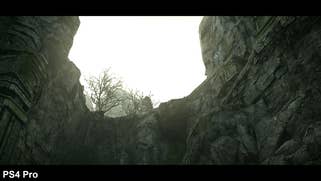
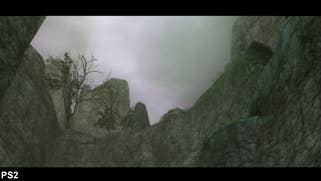
Beyond the lighting changes, new life is breathed into these environments thanks to a new foliage system which allows for thick fields of grass and richly detailed forests complete with leaves that blow gently in the breeze. As the player moves through these foliage, branches and blades of grass alike are displaced in your wake. Water is treated similarly well. On PlayStation 2, without the aid of modern programmable shaders, the team had to rely on tricks to create convincing bodies of water. The environment and characters alike could be blurred beneath the surface, mesh-based waves were used to add depth and a smoothly animated surface texture topped things off. On PS4, a rich water surface shader is used along with a combination of simple base reflections and more taxing screen-space reflections too.
The last major piece of the environment puzzle is the sky; the original game simulated the appearance of high dynamic range lighting - a miracle for the PS2 hardware - but its signature look is tied to the appearance of bright light piercing holes through the clouds. The strong bloom component lends the game a unique appearance which is common to games produced by Ueda.
For this remake, Bluepoint has made certain to recreate this aspect of the design with a new, more realistic cloud layer. Light is seen penetrating holes within the sky in a fashion like the original, the difference being that cloud shadows are now cast onto the environments, bringing further depth and realism. The same over-bright glare of the sky is still maintained beautifully in this remake and even better, this remake supports modern display-based HDR, allowing those bright spots to pop in a way the original never could.
It's also worth mentioning the excellent texture work found throughout the game. All the artwork needed to be recreated for this project and it looks superb. Parallax occlusion maps are combined with actual geometry and these new textures to help give the world a coating of fine detail. What's great about the new artwork is how closely it maintains the look and feel of a Team Ico game - the added resolution means it resembles The Last Guardian more than Shadow of the Colossus, of course, but it feels just right in this game world.
The next major upgrade can be found in motion - the animation was recreated from scratch enabling more natural motion while still recalling the look and feel of the original game. One of the major innovations featured in Shadow of the Colossus is the reliance on real-time inverse kinematics calculations. This technique allows models to more realistically interact with surfaces by properly connecting with all manner of slopes and edges - it adds a new dimension to both traversal and Colossus battles.
With the PS4 remake of the game, Bluepoint has recreated the animation from scratch while utilising the additional processing power of the PS4 to improve IK calculations. As a result, Wander's feet more realistically connect with the terrain and Colossus battles feel more natural as well. There is a newfound fluidity to everything that greatly enhances the experience of playing Shadow of the Colossus.
All of this is enhanced by a robust post-processing pipeline including a rich depth of field and, more importantly, per object motion blur. The original PS2 release is well known for its impressive attempt at simulating this effect on a system that wasn't capable of a per-pixel motion blur at all. This was improved in Bluepoint's remaster of the game on PS3 with proper per-pixel blur applied across the scene. On PS4 though, the sample count and precision of the effect is greatly increased, and the shutter speed can be adjusted in the options menu allowing the effect to appear correct in both visual modes on the PS4 Pro.
Looking at the package as a whole, it's remarkable how dramatic an overhaul we're looking at here. Bluepoint's engine enables some truly breathtaking moments and gloriously detailed scenes - and everything runs locked at a solid 1080p30 on base PlayStation hardware, rising to 1440p30 on Pro (with downscaling supported for 1080p display users), backed by an excellent TAA solution that looks great on both full HD and 4K screens. But there's more: PS4 Pro users also have the option of a performance mode that doggedly locks to 60fps for the vast majority of the experience.
We've seen this kind of performance in an open world title with Metal Gear Solid 5, but how common is it to find a game of this scale operating at such a smooth frame-rate? It's true that the world is mostly empty and this no doubt helps keep the performance up but we were genuinely floored by the experience of playing a game this beautiful at 60fps on a console.
The stability of the frame-rate combined with the excellent motion blur results in one of the smoothest feeling games we've played since Doom 2016. By and large, 60fps means 60fps, but we did note the tiniest of drops in the main template area, where we could trigger a handful of torn frames. It's entirely possible that other areas could drop but, after finishing the first seven Colossi in the game, we've yet to encounter any other spot in the game with this same issue - it's our preferred way to play the game.
We've been debating this amongst the team since the review code arrived, but we think it's fair to say that Shadow of the Colossus does stand as one of the finest remakes of all time. Is it the best? That's a difficult call to make, but the reasons for bestowing Bluepoint's work with this accolade are many: firstly, the visual update is sublime. It's a remake of a game that first appeared in October 2006, but regardless, the studio has delivered one of the most visually beautiful games of the generation. The fact that it offers a 60fps mode on top of that is just the icing on the cake.
Secondly, there's the controls - this is a game that has always exhibited somewhat laggy, unresponsive controls. While it's never stopped many from loving the game, the improvements made in this new release help make for a more playable game all around. It just plays better, but if you're a stickler for the original,, the team has offered the option to play with classic controls as well which more closely emulate the original game. Having both options in a remake helps strengthen its case as one of the best.
Thirdly, there are the extra features. A wonderful and very capable photo mode is introduced, for instance, and works wonderfully while the filters are an excellent bonus that is great for replays. Finally, there's the understanding of the source material. When rebuilding a game, nailing the originally intended atmosphere and sensation of playing a game is very difficult. From the very beginning of the game, however, it's clear that Bluepoint has approached its design in an obsessive fashion - this is a team that truly understands and cherishes Shadow of the Colossus and possesses the technical skill to deliver state-of-the-art visuals up there with the best of the console generation, while retaining everything that makes the original experience so special.
And this is what makes Bluepoint's work here so exemplary - it has taken onboard the technical ambition of Team Ico's original work and scaled it across the console generations, but the studio has also delivered it with the polish and performance that made projects like Uncharted: The Nathan Drake Collection such an impressive achievement. A Last Guardian remake for PlayStation 5 (or even PS4?) based on this technology? We'd love to see it.
